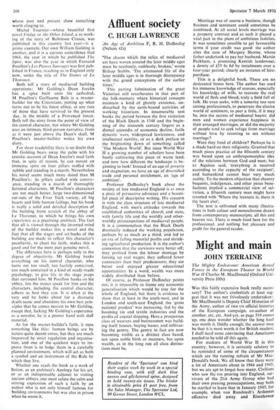Affluent society
C. HUGH LAWRENCE
An Age of Ambition F, R. H. DuBoulay, (Nelson 42s) `The charm which the relics of mediaeval art have woven around the later middle ages must be resolutely, ruthlessly, broken,' wrote Bishop Stubbs. 'The attenuated life of the later middle ages is in thorough discrepancy with the grand conceptions of the earlier times' This parting fulmination of the great Victorian still reverberates in that part of the folk-memory where historical concepts maintain a kind of ghostly existence, un- disturbed by the earth-bound activities of working historians. In innumerable text books the period between the first visitation of the Black Death in 1348 and the begin- ning of the sixteenth century lingers as a dismal appendix of economic decline, futile dynastic wars, widespread lawlessness, and intellectual sterility, or as a dark preface to the brightening dawn of something called `The Modern World'. But since World War II a growing number of scholars have been busily cultivating this piece of waste land, and now how different the landscape is be- ginning to look! Instead of an age of poverty and stagnation, we have an age of diversified trade and personal enrichment, an 'age of ambition'.
Professor DuBoulay's book about the society of late mediaeval England is at once a piece of persuasive advocacy and a beauti- ful piece of descriptive writing. His concern is with the class structure of late mediaeval England, with men's attitudes towards the established authorities of church and state, with family life and the worldly and other- worldly preoccupations of mediaeval people.
It is a commonplace that the Black Death drastically reduced the working population, perhaps by as much as a third, and led to an era of falling manorial profits and shrink- ing agricultural production. It is the author's contention that the survivors were better off; they profited from the labour shortage by forcing up real wages; they suffered fewer constraints than their predecessors; they ate better and enjoyed greater educational opportunities. In a word, wealth was more widely distributed than before.
Of course, as Professor DuBoulay points out, it is impossible to frame any economic generalisation which would-be true for the whole of England, but there is evidence to show that at least in the south-west, and in London and south-east England, the 'gross national product' was increasing, fed by the booming tin and textile industries and the profits of coastal shipping. Here a prosperous class of weavers and businessmen was build- ing itself houses, buying leases, and infiltrat- ing the gentry. The gentry in fact are now becoming visible as a distinct class based, not upon noble birth or manners, but upon wealth, as in the long run all class distinc- tions must be, Marriage was of course a business, though business and sentiment could sometimes be combined. At all social levels marriage was a property contract and as such it played a vital part in the.plans of ambitious families. It was sometimes possible to get favourable terms if your credit was good: the author cites the case of Margery Shorne, whose father undertook to pay her husband, Martin Peckham, a promising Kentish landowner, a dowry of £53 6s 8d by instalments over a four-year period; clearly an instance of hire-, purchase.
This is a delightful book. There are no desiccated bones here. The author has used his immense knowledge of sources, especially his knowledge of wills, to recreate the real world of flesh and blood, truly a field full of folk. He even seeks, with a temerity too rare among professionals, to penetrate the elusive world of sentiment, to peer a little, if it may be, into the secrets of mediaeval hearts: did men and women experience happiness in their arranged marriages, or did the majority of people tend to seek refuge from marriage without love by resorting to sex without marriage?
Were they fond of children? Perhaps he is a shade hard on their religiosity. Granted that much pious practice of the fifteenth century was based upon an anthropomorphic idea of the relations between God and man; but as Aquinas said, 'everything is received according to the capacity of the recipient', and humankind cannot bear very much reality. To the modern objection that chantry bequests, indulgences, and other pious bene- factions implied a commercial view of sal- vation, a fifteenth century man might have retorted with 'Where thy treasure is, there is thy heart also'.
The text is enlivened with many illustra- tions in both colour and monochrome drawn from contemporary manuscripts; all this and heaven too. There is much food here for the professional, and nothing but pleasure and profit for the general reader.


































 Previous page
Previous page